–by Sharon Schroll
Q: Did you hear about the two bed bugs who met in the mattress?
A: They got married in the spring
–by Sharon Schroll
–by Jeff Whitworth — Field Crops
Much of the sorghum around northcentral Kansas is just starting to reach the flowering stage. This is the most susceptible stage for the attack of “headworms”. To visualize the potential of a “headworm” infestation in sorghum, or even a “podworm” infestation in soybeans, just remember all the armyworms/fall armyworms/corn earworms that have been chewing on alfalfa/brome/and lawns the past few weeks. These larvae are, or have been, pupating and the adult moths will be, if they are not already, flying around depositing eggs on susceptible plants. Remember, sorghum is vulnerable to “headworms” from flowering until soft dough. “Headworms” cause 5% loss/worm/head but the infestation needs to be detected as early as possible while the larvae are still small (see fig 1. Relatively young corn earworm larvae from sorghum head on 24 Aug). The larger the larvae the more grain they have damaged and will continue to damage until they pupate.

Figure 1. Young corn earworm larvae from sorghum (pic by Cody Wyckoff)
At the same time, sugarcane aphids are continuing to migrate into Kansas. Individual winged aphids are relatively common now, plus a few colonies. There are even a few colonies that are starting to cause concern (see fig 2. of a field in Geary County). Monitoring for “headworms” thus needs to continue in each field until the soft dough stage and for sugarcane aphids through the hard dough stage. For more information, regarding treatment thresholds/sampling/and products registered for the control of “headworms” or sugarcane aphids please refer to the 2021 KSU Sorghum Insect Guide.

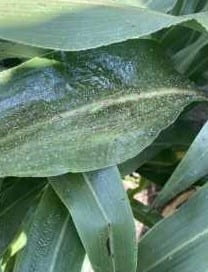
Figure 2. Sugarcane aphid colonies – photos provided by Mr. Chuck Otte, Geary County Extension.
by Raymond Cloyd—Horticultural Entomology
–by Jeff Whitworth — Field Crops
“Worms” are not the only pests feeding on crops right now! Grasshoppers (see fig 5) are especially numerous this year and will also continue to feed into the fall and continue to deposit eggs in the soil mainly in undisturbed areas adjacent to crop fields. (All pictures by Cody Wyckoff)
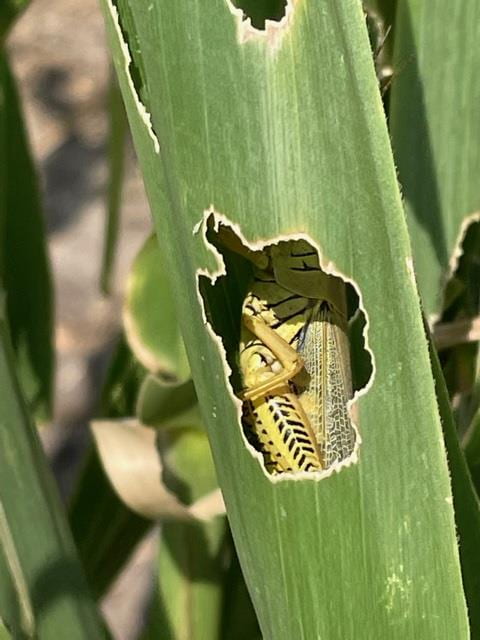
Figure 5: Grasshopper feeding in corn
–by Jeff Whitworth — Field Crops
“Worms” have been voraciously feeding throughout at least the eastern 2/3’s of Kansas for about the last 3 weeks. However, they have only recently gotten large enough to cause considerable damage and thus concern. The main problem in alfalfa, so far, seems to be a combination of fall armyworms (see fig 1), armyworms (see fig 2), and somewhat surprising, alfalfa caterpillars (see fig 3).
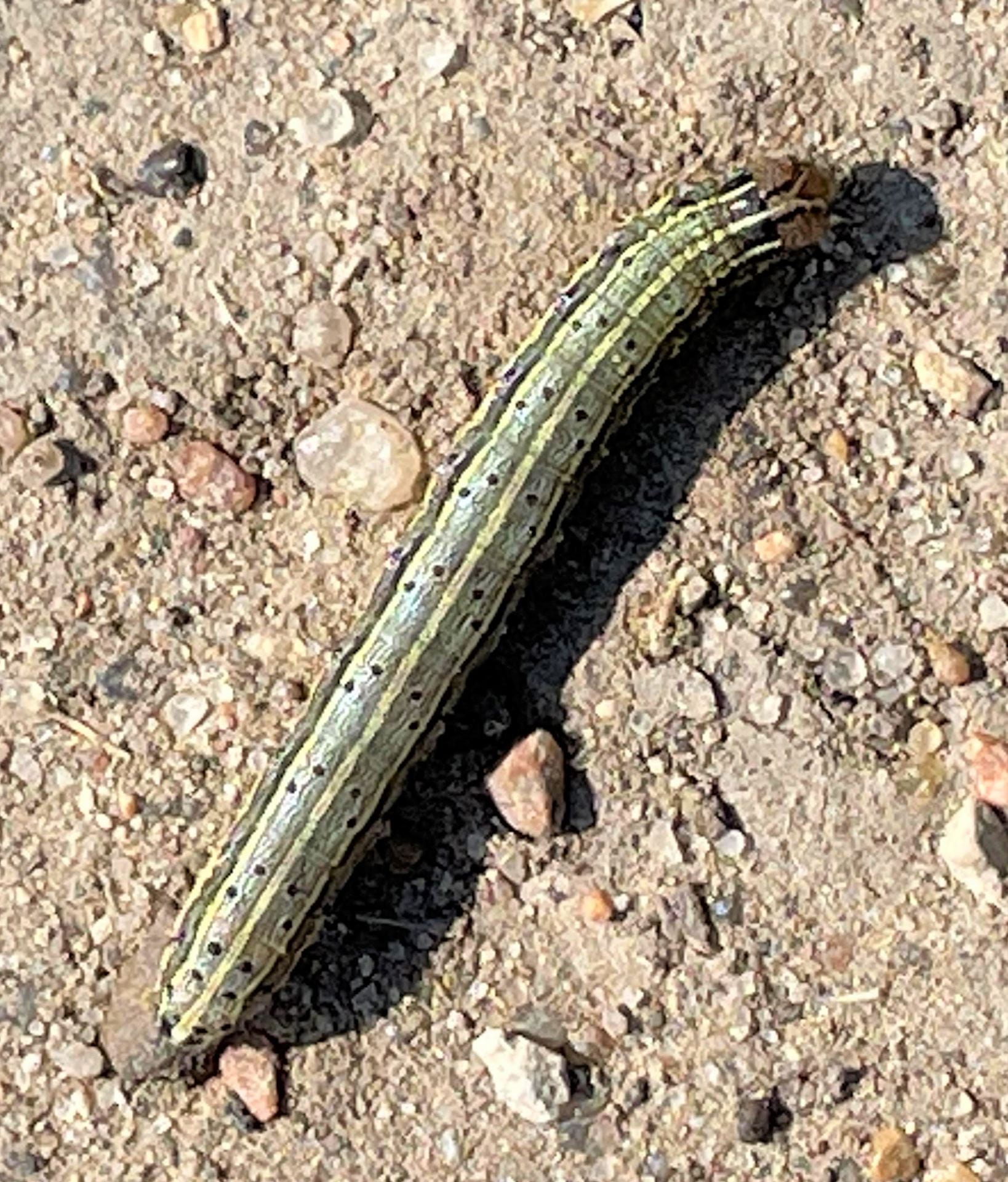
Figure 1: Fall armyworm
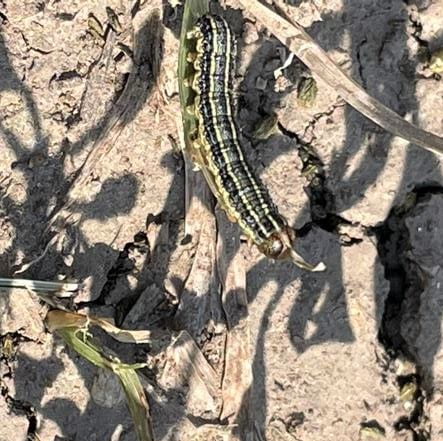
Figure 2: Armyworm

Figure 3: Alfalfa caterpillar
Alfalfa caterpillars are usually quite common in alfalfa and soybeans, however, not at the densities detected this year. Alfalfa caterpillars pupate then emerge as the common yellow (see fig 4) or white butterflies usually seen flying around alfalfa and soybean fields.

Figure 4: Adult alfalfa caterpillar
Regardless of which larval species, it is apparent that the majority of the larvae are relatively mature and thus will be/or are pupating soon. Pupation will probably take 4-5 days. Then the adults will emerge, mate and start depositing eggs. These eggs will hatch, and then in 4-7 days the new, but very small, larvae will start the feeding process all over again. Armyworms (fig 2) will attack mainly grasses, i.e. brome, late-planted sorghum, wheat, etc. Alfalfa caterpillars (fig 3) will mostly stay in alfalfa or soybeans, before they get too mature, and fall armyworms (see fig 1) may feed on just about any crop. However, sorghum should only be susceptible to “headworms” from flowering until soft dough. All three species may have at least one more generation, if not more, until a hard freeze puts a stop to them.
–by Raymond Cloyd — Horticultural Entomology
Fall armyworm, Spodoptera frugiperda, caterpillar infestations are prevalent throughout Kansas with the caterpillars causing damage to turfgrass (e.g. Bermuda grass). For information on Identification, Description, Damage, and Management strategies please refer to the two-page extension publication using the following link:
–by Raymond Cloyd — Horticultural Entomology
The second generation of the fall webworm, Hyphantria cunea, is now present throughout most of Kansas with webs present on certain trees such as hickory and walnut. Fall webworm nests are noticeable, with silk webbing enclosing the ends of branches and foliage or leaves (Figures 1 and 2).
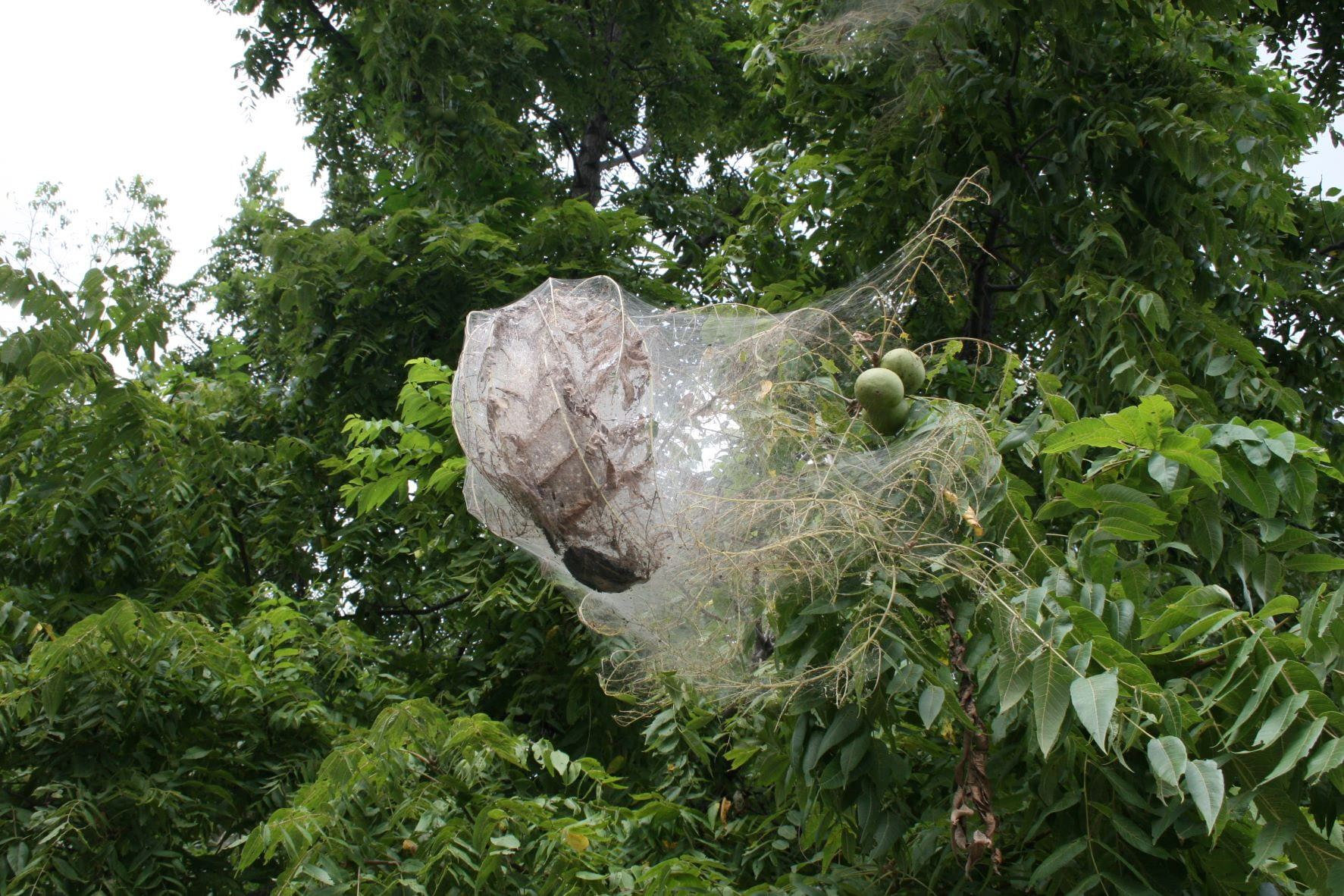
Figure 1. Fall webworm nest on walnut tree (Raymond Cloyd, KSU)

Figure 2. Fall webworm nest on birch tree (Raymond Cloyd, KSU)
Fall webworm larvae or caterpillars are pale-green, yellow to nearly white, with two black spots on each abdominal segment. Caterpillars are covered with long, white hairs (Figure 3).

Figure 3. Close-up of fall webworm larvae (Raymond Cloyd, KSU)
Fall webworm caterpillars feed on a wide range of trees, including: birch, crabapple, maples, hickory, pecan, mulberry, and walnut. Fall webworm caterpillars, unlike caterpillars associated with the eastern tent caterpillar, Malacosoma americanum, remain within the enclosed webbing and do not venture out to feed. Caterpillars consume leaves, resulting in naked branches with webbing attached, which contains fecal deposits (frass) or ‘caterpillar poop’. These nests will eventually dry-up as the caterpillars transition into pupae, with adults eventually eclosing (emerging) from the pupae later on in the growing season.
Feeding by fall webworm caterpillars at this time of year is typically not directly harmful to trees—especially larger trees. The most effective method of dealing with fall webworm infestations is to prune-out the webs that enclose the caterpillars, place into a plastic bag, and dispose of immediately. Insecticide sprays are not be effective because the caterpillars remain in the webbing while feeding; thus reducing exposure to spray residues. If insecticides need to be applied, use high-volume spray applications that penetrate the protective webbing, or use a rake to disrupt or open-up the webbing so that the insecticide spray contacts the caterpillars.
–by Anthony Zukoff — Southwest Research and Extension Center
Weather patterns can have a significant impact on grasshopper populations year to year. Hot, dry summers increase survival of nymphs and adult grasshoppers, leading to increased egg production during the growing season. Cool, wet weather promotes fungal pathogens that can reduce egg and nymph survival, but if the following spring is warm and wet, egg hatching will increase and more nymphs survive. So, several years of hot, dry summers followed by warm, wet springs can eventually lead to large populations of grasshoppers in some regions.
As the weather in western Kansas continues to be hot and dry this summer and areas of drought increase, larger populations of grasshoppers going into the fall season could be possible. This year’s USDA Rangeland Grasshopper Hazard map (Figure 1) may explain the recently observed buildup of grasshoppers along field edges and in grassy areas. As non-crop sources of food are exhausted, grasshoppers will shift their grazing over to anything still growing in the landscape. In areas with greater grasshopper pressure seedling alfalfa and wheat could be at risk.
Before planting alfalfa, treatment should be considered if there are 15 or more grasshoppers per square yard around the planting area. Once planted and growing, consider treatment if 3-5 grasshoppers per square yard are found in the seedling alfalfa stand.
Vegetated borders around areas where wheat will be planted should be scouted 10 days before planting. Consider treating those borders if there are 7 to 12 grasshoppers per square yard. Once growing, 3 or more grasshoppers per square yard within the field can destroy seedling wheat stands. If grasshopper populations are low to moderate, seed treatments can protect emerging wheat plants for several weeks if products are applied at the highest registered rate. Seed treatments will be less effective under severe grasshopper pressure. Avoid planting too early as this will help reduce the time that wheat will need to be protected.
In either crop, depending on the products used and severity of the season’s grasshopper buildup, multiple applications might be necessary. Please refer to the most recent Alfalfa and Wheat Insect Management Guides for specific control information.
Alfalfa Insect Management Guide: http://www.bookstore.ksre.ksu.edu/pubs/MF809.PDF
Wheat Insect Management Guide: http://www.bookstore.ksre.ksu.edu/pubs/mf745.pdf

Figure 1. Areas shaded in orange and red could experience increased grasshopper pressure through this fall.
–by Sharon Schroll
–by Dr. Jeff Whitworth — Field Crops
Sorghum throughout north central and southcentral Kansas is still in many different stages of development. So far, sorghum pest problems have not been as readily apparent as in most past years–but there is probably still 2 months remaining to stay vigilant. Chinch bugs have not been as problematic as in past years, because either populations are down or we are learning how to better manage early season chinch bug problems.
Many corn earworms (see pic 1) are still feeding in corn and thus have yet to pupate, emerge as adults, and then start flying around after mating looking for oviposition sites in soybeans or sorghum. Sorghum is attractive to these “headworms” only between flowering and soft dough. Therefore, some sorghum fields may be past the susceptible stage. The moths will then usually head to soybeans to deposit eggs.

Picture 1: Corn earworm (pic provided by Cody Wyckoff)
The other problem we may have in sorghum in southcentral and north central Kansas are aphids. Corn leaf aphids have been in corn and sorghum in easily detected numbers since the whorl stage corn (mid-June) and are still relatively abundant in whorl stage sorghum (see pic 2) on 11 August. Corn leaf aphids rarely occur in densities to cause a negative impact on many plants. However, they do provide a good source of food for beneficials, i.e. please note the “mummies”(parasitized aphids) in the photo provided by Mr. Mills.

Picture 2: Corn leaf aphids (pic provided by Mr. Sean Mills, BASF)
This beneficial buildup may aid greatly toward controlling other aphid infestations like the one shown here (see pic 3) of sugarcane aphids which seem to be just starting to colonize sorghum in southcentral KS. from migratory adults just arriving from infested fields south of Kansas. Sugarcane aphids have been detected in several counties south of Hwy 50, so far, but not yet in densities approaching treatment thresholds. Hopefully, with healthy populations of beneficials these sugarcane aphids will be kept under treatment thresholds. As south winds continue, however, expect sugarcane aphids to continue to migrate into southern counties and then north throughout the state. Thus, monitoring and early detection are important.

Picture 3: Sugarcane aphids (pic provided by Mr. Jeff Seiler, Sg. Co.)